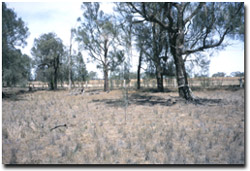Site 4 Bryce’s Buloke
Site is of uncertain environmental stability
Description
The area is freehold and fenced from grazing. The site has an altitude of 150 m and a gentle easterly aspect. The area is on an almost level alluvial plain. The area is of low habitat value due to low numbers of habitat trees, small site size and adjacent farmland.
| Vegetation Description and Composition This freehold site comprises Open Woodland dominated by Allocasuarina luehmannii (Buloke) and the EVC represented is Plains Grassy Woodland. Almost 50% of total species present are introduced, being mainly pasture weeds. Native grasses dominate the herbaceous layer. Three salt indicator plants are still present and are Chloris truncata (Windmill grass), Lolium spp., (Rye grass) and Enchylaena tomentosa (Ruby saltbush). The presence of these species does not necessarily indicate salinity for they are commonly found in the Plains Grassy Woodland EVC. Soil tests need to be performed to be certain. The vrot Maireana humillima (Dwarf blue bush) was still present in spring 2002. There appears to be a slight change in vegetation survey results when compared with previous survey data. In 2002, the total number of species present was similar, but the particular species are changing to more drought tolerant species. The level of abundance of introduced grasses and members of the Asteraceae Family have again decreased, due to the continued dry conditions. |  Bryce’s Buloke is only low quality habitat due to its small size and is surrounded by cropping |
Tree Health
Eight trees are monitored for tree canopy health using a 20-point system assessing canopy size and density, number of dead branches and extent of epicormic growth. Leaf damage by insects is also assessed. It needs to be stated that this test does not correspond well to assessing the health of Buloke trees, because it was developed for assessing Red Gum and Black Box tree health. All trees are reasonably healthy however there are no signs of regeneration, which is a concern for the future ecological health of this site. Buloke trees are extremely slow growing and may die out if new regeneration does not occur soon.
Groundwater and Salinity
The one bore near the site is showing a slight linear rising trend despite prevailing dry conditions. The water table is still >8 m below surface. Given the relatively deep watertable level at this site and the considerable areas of higher risk ground not yet affected by salt, it is possible, though not certain, that this site may not be at risk from salinity. Salinity levels recorded in 2002 were 18 190 EC, extremely saline groundwater.
Birds
Bird species present at the time of the vegetation and tree health surveys were :-
Chestnut-rumped Thornbill, Galah, Magpie, Red-rumped Parrot, Starling, Welcome Swallow, White-plumed Honeyeater, Willie Wagtail, Yellow-rumped Thornbill, Brown Falcon, Eastern Rosella and Little Raven.
Threats to the site continue to be:
- weed invasion from adjacent farmland and roadside Phalaris spp. (Canary grass)
- potential loss of Allocasuarina luehmannii (Buloke) due to limited regeneration


